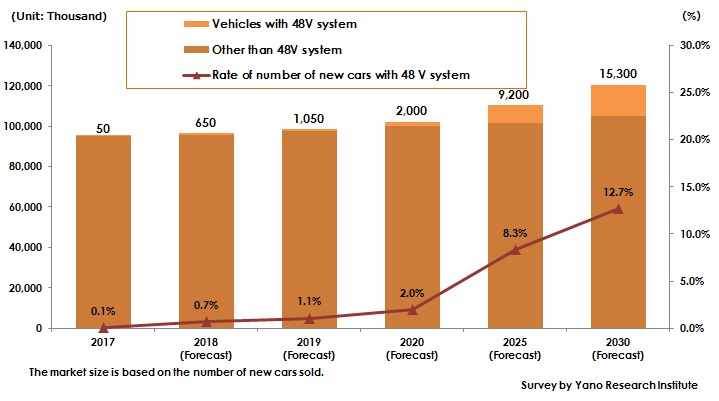No.1967
Global 48-Volt Mild Hybrid System Market: Key Research Findings 2018
Global 48-Volt Mild Hybrid System Market: Key Research Findings 2018
Yano Research Institute (the President, Takashi Mizukoshi) has conducted a survey on the global 48-volt mild hybrid system market and has found out the market trends by configuration (ISG, inverter, DC-DC converter, battery for 48-volts) and trends of the leading companies pressing ahead with the strategies of electric vehicles, and the future global outlook based on such information.

Market Overview
The internal combustion locomotives are expected to diminish because of shift to the next-generation vehicles (i.e., HEVs, PHEVs, EVs and FCVs) due to stricter environmental regulations. However, it is unthinkable for next-generation vehicles to occupy the market all at once because of the issues of costly vehicle prices, limited cruising distance, and incomplete infrastructure including power charging stations. As a solution to solve these issues, 48-volt systems are attracting attention for its availability by minimum design modifications of conventional internal combustion locomotives.
On the other hand, 48-volt systems are in the initial stage of being accepted. With the intention of recovering their capital by makers, the systems are currently installed primarily in high-end cars and SUVs due to their higher profit ratios. Though in a status where the global number of new car sales in 2017 ended up with only 50,000 vehicles, 48-volt systems are expected to expand as low-price hybrid systems, until PHEV and EV prevail in the future markets. In fact, several automakers primarily in Europe and China have started releasing 48-volt-system installed vehicles.
Noteworthy Topics
In around 1920s when in-vehicle batteries were first mounted, such batteries had been used only for headlamps, blinkers, ignition to start the engine, and etc., needing only 6 volts to cover. Later, in around 1950s, alternators, car radios and other electric equipment came to be installed in a car, which raised the voltage of the batteries to 12 volts. Ever since, up until now, 12-volt systems are used for passenger cars. However, electric equipment installed in a car has by far wider in variety now when compared with in 1950s, added with many improved systems in safety, convenience, and other functions. This has greatly increased electric consumption in an entire vehicle.
As five German automakers (VW, Porsche, Audi, Daimler, and BMW) stipulated the industrial standard “LV148”, VDA (German Association of the Automotive Industry) in 2013 formulated “VDA320” a quality management specification to regulate voltage domain and how to cope in case of system failure, aiming to quickly prepare an environment for suppliers to provide 48-volt M-HEV systems. Such standardization facilitates using of the common components such as circuit structure and etc. among German automakers, encouraging the systems to be more efficiently developed. This seems to indicate that German automobile companies in unison have determined to generalize 48-volt M-HEV systems.
If accepted more widely and globally, 48-volt systems can be the competition of rechargeable batteries, drive motors, and controllers that Japanese makers have preceded in marketing and have succeeded in mass production in the field of hybrid systems. A new competition has emerged between strong hybrid systems (the systems that the Japanese automakers have taken time to build) and low-cost mild 48-volt HEV systems that the German automakers in unison tackling to develop.
Research Outline
2.Research Object: Automakers, automotive system makers, etc.
3.Research Methogology: Face-to-face interviews by the expert researchers, survey via telephone and email, and literature search
What are 48-volt systems?
A passenger car use 12-volt electrical power for headlights, blinkers, and audios.
48-volt systems are the systems with higher voltage than conventional ones that are consist of motor/generator (ISG), batteries for 48 volt system, and DC-DC converters, etc. 48-volt systems in this research indicate those car models and their components that automakers are currently developing as “48-volt mild hybrid (48V M-HEV.)”
Published Report
Contact Us
The copyright and all other rights pertaining to this report belong to Yano Research Institute.
Please contact our PR team when quoting the report contents for the purpose other than media coverage.
Depending on the purpose of using our report, we may ask you to present your sentences for confirmation beforehand.